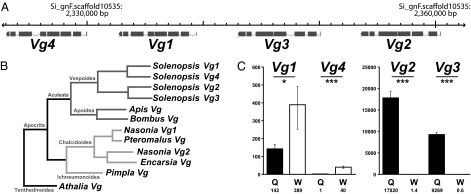Fig. 3.
S. invicta vitellogenins. (A) Four vitellogenins are located within a single 40,000-bp region of the S. invicta genome. (B) Parsimony tree of known hymenopteran vitellogenin protein sequences suggests that two rounds of vitellogenin duplication occurred after the split between ants and other hymenopterans including bees and wasps. (C) Quantitative RT-PCR of the four putative S. invicta vitellogenins on whole bodies of major workers (W) and mated queens (Q) (n = 10). The y axis indicates mRNA concentrations for the different vitellogenins. Values depicted by each bar are shown below the x-axis labels. Error bars represent SEs. Expression differences between queens and workers were significant (Bonferroni-corrected two-tailed t tests: *P < 0.05, ***P < 10−10).

